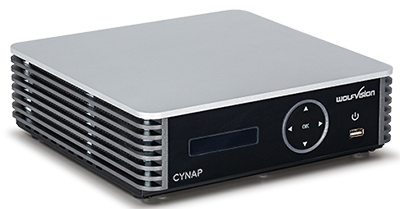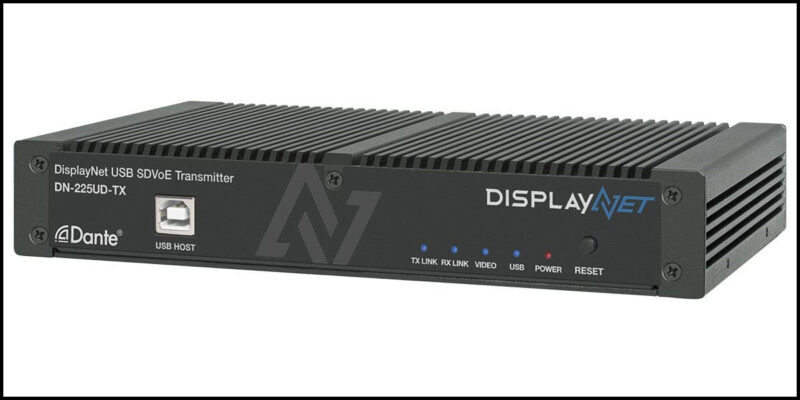Open and Closed — Brief Discussion of WolfVision and Kramer
 Post-InfoComm, the good folks at WolfVision brought their new Cynap collaboration appliance to the office for a demo and a chat. Cynap is the latest entry into the increasingly crowded wireless collaboration space, competing with not only the WePresent and its OEM cousins (Barco Clickshare CSM, Crestron Air Media, Extron Sharepoint, etc.), but also with the purely software-based Mersive Solstice and Kramer’s software/hardware hybrid Via. Specific product capabilities aside, distinctions between these raise interesting big-picture philosophical design questions worth exploring.
Post-InfoComm, the good folks at WolfVision brought their new Cynap collaboration appliance to the office for a demo and a chat. Cynap is the latest entry into the increasingly crowded wireless collaboration space, competing with not only the WePresent and its OEM cousins (Barco Clickshare CSM, Crestron Air Media, Extron Sharepoint, etc.), but also with the purely software-based Mersive Solstice and Kramer’s software/hardware hybrid Via. Specific product capabilities aside, distinctions between these raise interesting big-picture philosophical design questions worth exploring.
The first thing that interested me is how WolfVision discusses the genesis of its collaboration appliance as an outgrowth of its well-known line of document cameras. One way for this segment to stay relevant in a world increasingly focused on digital media is to bring the collaborative tools on which we’ve come to rely to the world of physical objects; a document camera that can also share content wirelessly, annotate and even stream it to another room is a far more interesting, valuable and modern device than a document camera which simply takes a picture. With the addition of an extra video input or two, such a device might even be all one needs for a small classroom optimized for local presentations. The next logical step, of course, was to take away the camera. Again, the world is becoming digital. Some applications might still need a document camera, but there are more which will find use for the collaborative tools but NOT need to bring in physical objects.
In my mind, this leads to an obvious next question: You took the camera out of the box. Why not now take the box out of the box? Everything that the Cynap does — screen mirroring from mobile devices, whiteboarding, streaming — is, like nearly everything else we do, a software application. Why not let it be just software? It would allow an instance of Cynap to run virtually on a server in some environments, share space in a room PC with a soft-codec and other tools, or be deployed as an appliance for those cases in which an appliance is appropriate. This was not rights direction Wolfvision has chosen to take; under the hood, the Cynap is a fairly custom Linux application that they have no intention of freeing from the box. The company’s reasoning — and there is a measure of logic to this — is that it wants to ensure that users do not have a poor experience due to decisions outside of Wolfvision’s control. It is the same reason that it does not allow third-party applications to run on the device; there is some form of videoconferencing coming, but it will be a custom application with plans to cooperate with other types of endpoints over the BlueJeans network. If a user wants something else, they’ll need to work directly with Wolfvision to accommodate them.
 Contrast the Kramer Via. The larger Via appliance is, under the hood, a Windows 7 machine. This means that virtually any Windows 7 application can run on it and, to varying extents, take advantage of Via’s sharing and collaborative tools. If you use Skype for Business as your communications tool, download Skype onto the Via. If you later switch to a Google Apps environment, then you can easily delete Skype and load Hangouts. Or keep both. An argument can be made that this increases the responsibilities of IT support staffs for revision control if nothing else. While this is a fair point, this is a big part of what IT staffs do. It is, perhaps, an invisible cost, but in a large enterprise environment it might be a very minor one; at a certain level of deployment it might mean little more than a slightly increased workload for existing support staff.
Contrast the Kramer Via. The larger Via appliance is, under the hood, a Windows 7 machine. This means that virtually any Windows 7 application can run on it and, to varying extents, take advantage of Via’s sharing and collaborative tools. If you use Skype for Business as your communications tool, download Skype onto the Via. If you later switch to a Google Apps environment, then you can easily delete Skype and load Hangouts. Or keep both. An argument can be made that this increases the responsibilities of IT support staffs for revision control if nothing else. While this is a fair point, this is a big part of what IT staffs do. It is, perhaps, an invisible cost, but in a large enterprise environment it might be a very minor one; at a certain level of deployment it might mean little more than a slightly increased workload for existing support staff.
An appliance such as the Cynap, of course, is still software on the inside and still should have some level of support. In this case, however, support flows from the manufacturer. The rather hefty initial price-tag for the Cynap, in a traditional hardware model, included a two-year service contract. To contrast, more purely software applications might have a very low or even zero initial cost coupled with an annual license fee based on numbers of seats. This kind of solution is interesting in that it completely rewrites the usual practices of those of us in the AV business: Capability becomes more fluid, cost is better measured in operational rather than capital expenses and, ironically, a measure of customization is lost.
In case it isn’t clear, my personal bias is towards open systems and devices. Allowing third-party application invites customization, personalized decisions and leverages the countless thousands of hours many, many workers in the software industry have spent developing tools and applications. A device that can access Windows or even Android or iOS applications already has the support of large-scale developer communities, while a closed device is restricted to in-house programming staff. On the other hand, of course, I’ve had clients who prioritize reliability and consistency of experience over flexibility. This includes end users who would, in my estimation, be very well served with software solutions but have concerns about support, revision control and reliability. For such clients a closed device such as the Cynap can be an excellent fit; from the perspective of the clients’ internal support team, it’s a (literal in this case) black box that does what you want it to. Yes, they lose flexibility to add new Windows applications. With that they lose the task of managing Windows updates, security concerns and a slew of support tasks.
As I said, I have my biases. That doesn’t mean that they’re always right, and that sometimes a closed box isn’t better than an open one.





